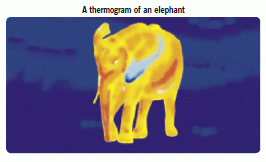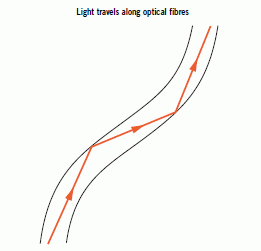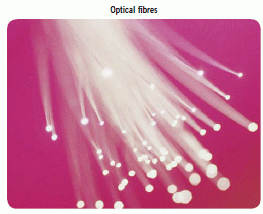Infrared
Uses of Infrared
Our skin detects infrared radiation and we feel heat.
All objects emit electromagnetic radiation that depends on their temperature. Hot objects glow red and very hot objects glow white hot, because they emit light as well as infrared. The hotter the object, the more electromagnetic radiation it emits and the higher the maximum frequencies.
Warm objects, like radiators and human bodies, emit infrared. Night-vision goggles, cameras and thermograms use false colour so that we can ‘see’ the radiation.

Infrared emission, absorption and reflection depends on the surface. When infrared is absorbed the particles in the surface vibrate and gain kinetic energy. This is why infrared radiation is used for cooking. The surface of food gets hot and then the inside is heated by convection and conduction. We must be careful that intense infrared radiation does not have this effect on our skin and cause burning. Some cooking appliances, like grills and toasters, emit red light as well as infrared.
Infrared radiation is used in remote controls for televisions and other electronic appliances. If you look at the beam from a remote control through a digital camera (which shows up infrared signals that our eyes cannot see) you can see the flashing infrared emitting diode sending the digital signal. These signals cannot pass through solid objects, but sometimes reflect off walls and ceilings to operate the television.
Communications
Infrared radiation and light are both transmitted along glass optical fibres by being reflected as shown in the diagram.

Optical Fibres
The fibres are made with a core that has a different refractive index to the outer cladding. Total internal reflection occurs at the boundary between the materials.
Digital signals can be sent for long distances using optical fibres because glass is transparent to visible light and infrared. When the signal needs boosting, digital signals are easily regenerated. A stream of data can be transmitted very quickly. Both infrared and red light lasers are used as radiation sources for fibre optic communications. Lasers produce a very narrow beam of intense radiation of one colour.
Total internal reflection can happen when light is refracted at a boundary with a less dense medium.
When the angle of incidence equals the critical angle the angle of refraction is 90º.
When the angle of incidence is greater than the critical angle total internal reflection occurs.

Advantages of fibre optic communication include:
- Infrared signals in fibre optic cables experience less interference (they pick up less noise) than microwaves passing through the atmosphere.
- Digital signals can be multiplexed, which is when signals are divided into sections and sent alternately so that many different signals can be sent along one fibre at the same time.
Lasers produce a beam with low divergence (does not spread out) in which all the waves have the same frequency and are in phase (in step) with each other.
Lasers are also used in a compact disc (CD) player. CDs store information digitally as a series of pits and bumps (0s and 1s) on the shiny surface.
A laser beam is reflected differently from the pits and bumps and a detector is used to ‘read’ the different reflections, reproducing the 0s and 1s of the signal.
